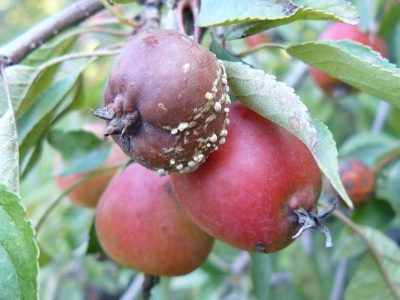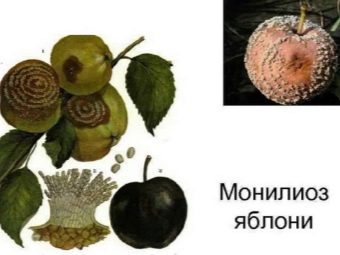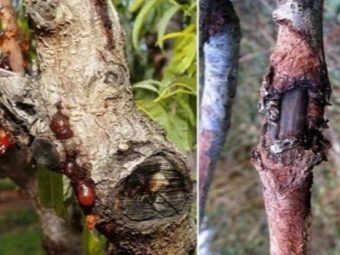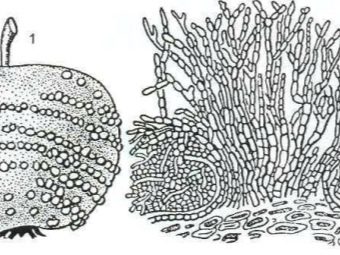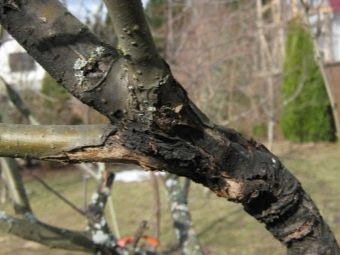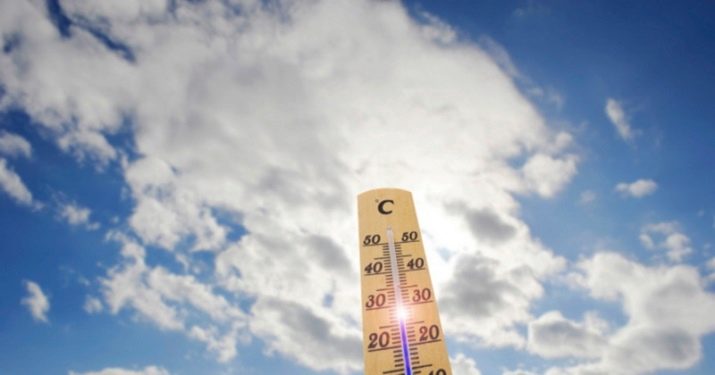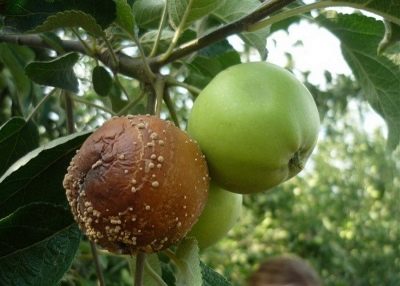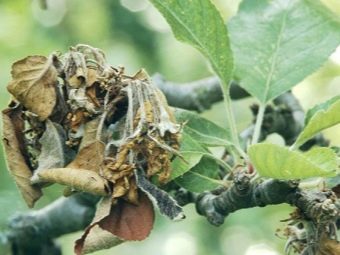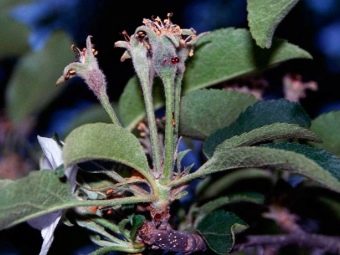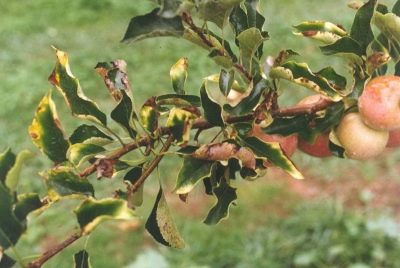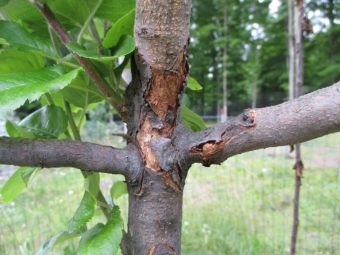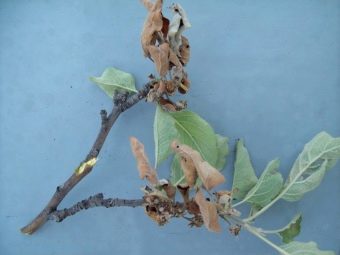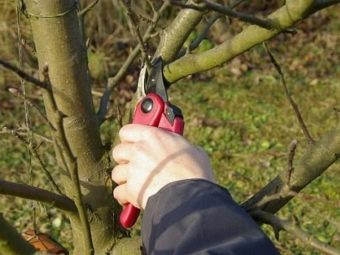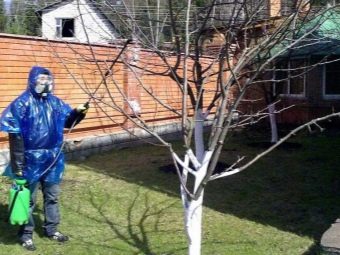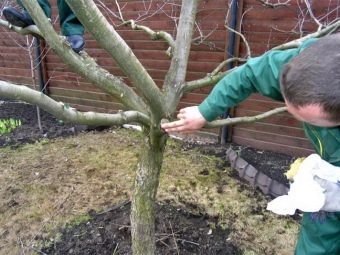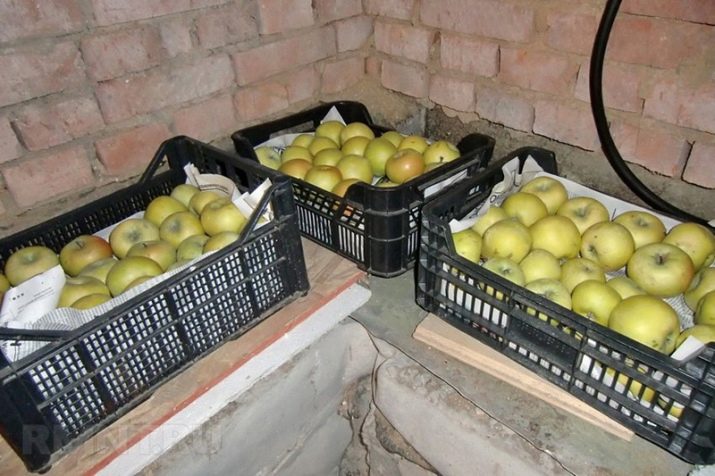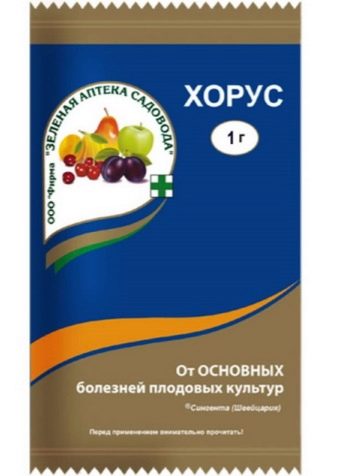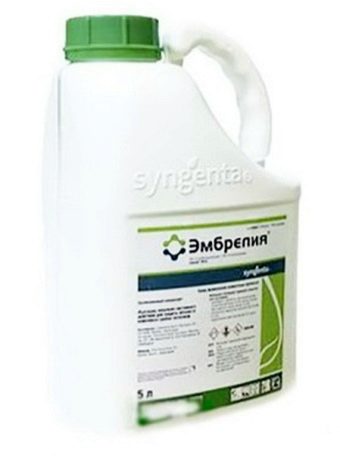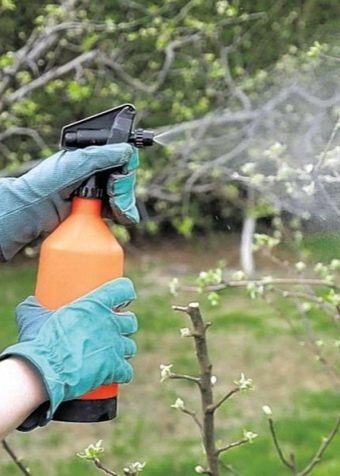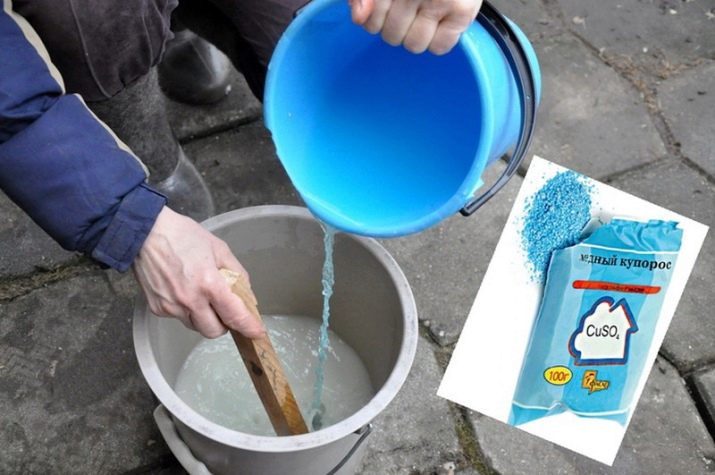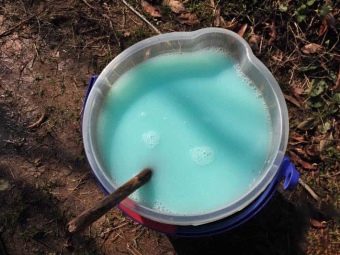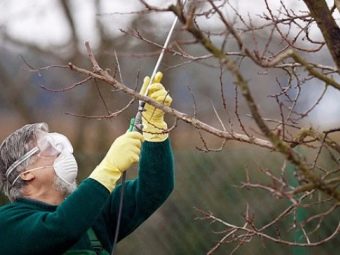Monilioz apple: the causes of the disease and treatment methods
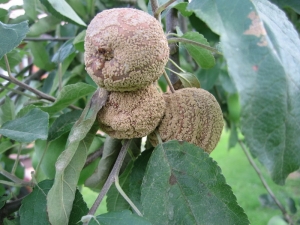
Among the fruit trees, various diseases are quite widespread, which can lead to the loss of fruits and, as a result, the gradual death of the tree. Apple trees most often affect diseases such as scab, moniliosis, alternariosis, powdery mildew. In this article, we will dwell in detail on moniliose and methods of dealing with it.
Special features
Monilioz apple - a fungal disease that infects the trunk of a tree and its fruits. Even if the crop is harvested, but the tree is infected, the disease continues to extend to the collected fruits, which is already an irreparable damage to the gardener, who risks staying without twisting and other delicious apple dishes.
The spread of moniliosis occurs by fungal spores, which first infect the bark of the tree, and then systematically spread through it during the flowering period and at the moment the fruits appear. Unfortunately, this type of infection can survive the winter and harm further.
There are two stages of disease multiplication.
- Conidial period. At this time there is an active sporulation, born spores, which consist of conidia, begin to spread rapidly throughout the bark of the tree. As a rule, have a gray color.
- Sclerocial period. This is the period of the so-called hibernation, the fungus is in the resting stage. Characteristic of the winter period, the disease has spread throughout the bark, and the pathogen is mummified in the fruit. The fungus moniliosis can winter up in the tree in the form of mycelium.
During the period of active flowering, moniliosis begins to act actively, infecting the buds, leaves, and branches. This is the most acute period of infection of the apple. With the advent of fruits, it strikes and them in the form of fruit rot.
What time does an active infection occur?
The active phases occur during flowering, the birth of buds and the transformation of the latter into fruits. The peak of infection occurs in the spring-summer season. If you do not take action, you can go without a crop. In the autumn, the spread of the disease begins as early as the harvest. In this case, act late, all fruits are unfit for food.
Acceleration of infection most often occurs in July - August, which is facilitated by the corresponding moderate or even hot weather.
- 25-28 ° degrees - It is suitable for the active phase of infection temperature. Please note that the months just coincide with the active fruiting.
- 75-90% - optimal air humidity for monilioz.
What does the disease look like?
There are two forms of moniliasis - fruit rot and monilial burn.
Fruit Rot
Identified throughout the Russian Federation. The fungus spreads evenly on the tree, and this leads to the fact that the resulting fruit is already infected. On the fetus, this can be seen in the form of brown spots, even with the naked eye.
Fruit rot will take only 5 days to fully infect, during which time the fruit will lose its color, and the flesh will become fresh and tasteless. Again, if the weather matches the parameters described above, then the infection will spread more quickly on the fruits. But do not rejoice if the temperature is lower and the weather is dry, in this case the incubation period and the infection is formed inside the fetus without its external signs. As a result, the apple is completely spoiled, acquiring a blue-black unappetizing shade.
Monilial burn
It is difficult to say which of the two diseases is worse - rot or burn. If in the variant with fruit rot it is possible to save the tree, and at the initial stages to partially save the crop, in the second case everything is much worse. Monilial burn infects the entire tree from the trunk to the leaves and the tips of the branches. This leads to the death of the plant, and then there can be no talk of any kind of harvest. This type of disease is characteristic of the south and regions of the Far East.
Symptoms of the disease
Symptoms of moniliosis are determined as early as 5 days after infection. Of course, it is difficult to call such a discovery pleasant. It is during this period that it is necessary to begin the immediate fight against the disease, before the sporulation begins. When the detection took place on day 10, it will be harder to fight the infection, but you can still stop its development. The following are common symptoms of fruit rot and monilial burn.
Their signs are:
- the appearance of brown spots;
- circular foci of decay with white swollen pads;
- pockets of swelling and so-called pads cover half of an apple;
- the presence of white pads indicates that the active phase of infection of the fetus has begun;
- during flowering, the flower becomes brown or black color;
- shedding flowers and ovaries;
- in trees where the fruit is already developing, the leaves do not fall off, but darken and curl - this suggests that the fruit itself is already at the stage of active infection.
Causes of
There are many reasons for the occurrence and spread of a malicious infection. Consider the most popular.
- Damage to the cortex. It may be various parasites, careless use of equipment near the trunk of a tree.
- Nearby diseased trees. Not only the apple tree in question, but also other fruit trees in the neighborhood are being checked for moniliosis and other illnesses. After all, the apple tree can be just healthy, but, for example, the pear is already amazed. It is worth remembering that the fungus spreads instantly, hoping that it will not happen to you is unwise.
- The consequence of other diseases. Weakened trees are an invitation to all kinds of diseases and pests. Do not allow their occurrence, in time carry out preventive measures.
- Instability to this disease. Unfortunately, not every variety boasts excellent resistance to fungal diseases. If neighbors often complain of illness, then it may be worthwhile to purchase more disease resistant varieties - “Pepin Saffron”, “Slavyanka”, “Parmen Winter Gold”.
- Non-compliance by the gardener of agrotechnical rules. The lack of prevention, improper planting, insufficient watering - all this can provoke the development of the disease. Even untreated inventory sometimes contributes to the spread of fungus in healthy cultures.
- Incorrect storage. Storage location and packaging may also be due to poor maintenance and non-compliance with minimum storage conditions.
Control measures
The fight against moniliasis begins in early spring, when everything is preparing for flowering and the formation of ovaries. Treatment continues in the summer. Treatment with fungicides should be carried out at least once every two weeks - this is both a preventive and protective measure. In addition to the fungicide, apply 5% solution of iron sulphate. It is also recommended to use the following tips.
- All collected infected tree elements (branches, leaves, fruits) should be buried outside the garden. Use them as humus is strictly prohibited.
- The crown should be carefully cut in order for the air at the top to circulate well.
- To prevent infection of neighboring trees, plant them at a distance of three meters from each other.
- It is necessary to treat apple trees at the moment when moniliosis appeared, but also from other infections that may be a precursor to the appearance of the fungus.
- The tree trunk must be fully protected from damage, if this happens, it is desirable to cut off the damaged branches, which will reduce the risk of disease.
Please note that even the simple process of whitewashing the trunk and branches, which is held in early spring, is already an excellent precautionary measure.
For storage of the crop, it is also necessary to carry out disinfection in order to protect the collected fruits and prevent the disease from developing indoors.
Follow these tips:
- the air temperature in the storage room should not rise above 0 ° C;
- spraying work tools, baskets and buckets;
- the room itself, where it is intended to store the harvested crop, must also be sprayed;
- after picking apples, carefully inspect the crop for rotten or diseased fruit.
Chemical treatments
"Skor" and "Horus" - chemicals that are used no more than three times. First of all, they are used to combat moniliosis and alternariosis. It can be said that these are “universal soldiers” who increase the general immunity of a tree. If they are carefully sprayed culture, it is possible that monilioz not manifest itself.
Embrelia is a fungicide intended for the integrated control of diseases and pests. This chemical can be used for up to three treatments. The recipe is as follows: consumption of 1.2-1.5 l / ha, the interval - 10-15 days. Natural landmarks can serve maturation, the development of a pink bud and the transition to the formation of the fetus. The big plus of this drug is that if the tree is only processed and it has started to rain, then it will not wash it away - the chemical will continue its healing effect.
Copper sulfate is a commonly used drug against fungal diseases. These are blue crystals of solid consistency. Once the solution is prepared, immediately begin spraying. The solution using copper sulfate is the following: 300 g of 3% of the product is diluted in ten liters of water and mixed thoroughly. For effective exposure to the substance, you will need 1.5-2 buckets on the tree, you should also consider the age of the apple. To prepare and use the solution, use only plastic tools.
Tips
In conclusion, it is necessary to give a few tips novice gardeners and refresh the knowledge of those who have long been engaged in gardening craft.
- To avoid sunburn from the sun and chemicals, spray either in the morning or in the evening. You can also do this in cloudy weather.
- Despite the fact that some of the drugs listed above in the article are resistant to rain, it is not recommended to carry out the treatment on the eve or during precipitation.
- If spraying is carried out, do it carefully and do not miss any part of the tree.
- When you dilute the drug with water, strictly follow the instructions, more - does not mean better.
Professional gardening or growing fruit trees is a serious and noble cause that requires a lot of work. To preserve and obtain a stable and rich harvest, be attentive to your garden, do not allow any signs of illness to drift away, then the wonderful fruits will not take long to wait.
On how to deal with moniliozom apple, see the following video.

